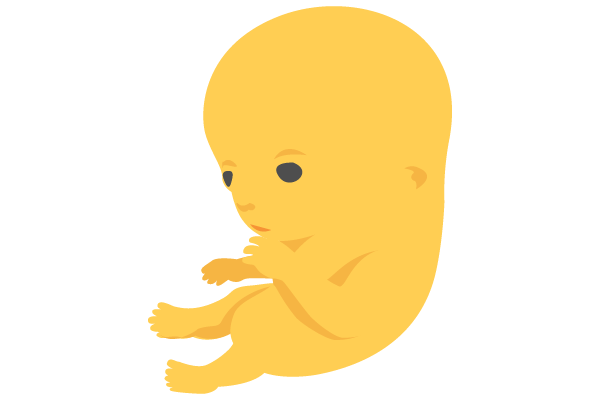
10 weeks pregnant
For information about weeks 1 through 11 of a twin or multiple pregnancy, tap here.
In week ten you’re heading into the tail end of your first trimester! And — fingers crossed — many of those common first trimester symptoms may be behind you soon too.
How’s Baby?
Baby is now the size of a kumquat, almost 1 ¼ inches long. Your little one is also beginning to develop tiny human features, like a teeny tiny bit of hair, the buds of baby teeth, and joints that bend. And if your baby is a male, their testes are just beginning to produce testosterone. Baby’s heartbeat — which is super rapid at this point around 170 bpm, about twice as fast as yours — can now be detected. Baby’s heart isn’t the only thing moving, either. Your tiny dancer is starting to move around enough that it will likely be visible in an ultrasound scan, which your healthcare provider may perform at your next appointment (if this hasn’t already happened). Baby’s digestive system is also functional by this point, transporting food matter to bowels in preparation for that first poop. How exciting!
What's new with you?
You are now a quarter of the way through your pregnancy! Hopefully this means that any common early pregnancy symptoms you may have been experiencing — like morning sickness, fatigue, or mood swings — should be lifting. You’re probably also going to start gaining weight at a more rapid rate soon, and your healthcare provider will track your weight gain to make sure that your pregnancy is progressing in healthy fashion. That being said, if you have a history of disordered eating and/or find weigh-ins triggering, you can request that your provider adjust the way they monitor your pregnancy. You have the right to feel comfortable with the healthcare you receive — during and after pregnancy
As far as pregnancy symptoms go, you might start to notice more visible veins, due to the extra blood being carried to Baby. In fact, the total blood volume in your body may increase 30-50% during pregnancy. (If you have a history of cardiovascular problems, this is something your healthcare provider will watch closely, as the increased blood volume can strain the heart.) You might also notice an increase in vaginal discharge around this time, which acts as a way to protect your baby from infection. If the discharge is whitish, thin, and odorless, that’s totally normal. But discharge that is tinged yellow or green or that has a thick or uneven texture could be a sign of infection, and this is also something to speak with your provider about.
During this time, you might also want to start thinking about genetic testing. There are several methods to screen for conditions including Down syndrome, congenital heart defects, and other chromosomal abnormalities. These tests are optional, and may or may not be fully covered by insurance. Talk to your provider about what is best for you — they’re there to be your expert guide through all the ins and outs of pregnancy.
Reviewed by the Ovia Health Clinical Team
Read more
Sources
- Dr Bahman Rasuli and Dr Yuranga Weerakkody et al. “Fetal Heart Rate.” Radiopaedia. https://radiopaedia.org/articles/fetal-heart-rate?lang=us.
- Sir John Dewhurst. Dewhurst's Textbook of Obstetrics and Gynaecology. 8th ed. Keith Edmonds. John Wiley and Sons Ltd, 2012. Print.
- Susan Storck et al. "Fetal Development." U.S National Library of Medicine. MedlinePlus. March 10, 2014. https://medlineplus.gov/ency/article/002398.htm.
- Mark A Curran, M.D. “Fetal Development.” Perinatology.com. Perinatology.com. March 31, 2019. https://www.perinatology.com/Reference/Fetal%20development.htm#1.




